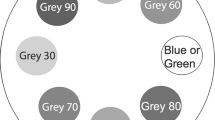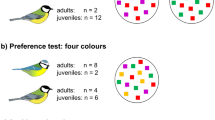Abstract
Crabs and shrimps (order Decapoda) use colours in various tasks such as foraging and mate choice. Colour vision requires at least two types of photoreceptors with different spectral sensitivities. Previous physiological studies revealed that most crabs including Scylla mud crabs have a single visual receptor system, i.e. they are colour blind. We determined colour vision by means of a behavioural experiment on hatchery-produced and wild-captured purple mud crab Scylla tranquebarica in a roofed hatchery. Adult crabs (8-10 cm carapace width) were subjected to classical conditioning to associate a food reward with a blue or a green stimulus placed among seven shades of grey. The hatchery-produced crabs learnt this task after 14 days of reward training, and thereafter distinguished blue in 27 non-reward trials, and green in 39 non-reward trials. The wild-captured crabs did so after 25 days of reward training, and distinguished green in 49 non-reward trials. These results indicated colour vision in S. tranquebarica. However, the crabs were unable to distinguish blue or green in dim light of 4.4 cd/m2 (which is slightly brighter than full moon light). The high colour vision threshold was attributed to the small optic parameters of the apposition compound eyes of S. tranquebarica.




Similar content being viewed by others
References
Alberts-Hubatsch H, Lee SY, Meynecke JO, Diele K, Nordhaus I, Wolff M (2016) Life-history, movement, and habitat use of Scylla serrata (Decapoda, Portunidae): current knowledge and future challenges. Hydrobiologia 763:5–21
Baldwin J, Johnsen S (2012) The male blue crab, Callinectes sapidus, uses both chromatic and achromatic cues during mate choice. J Exp Biol 215:1184–1191
Beyer I (1976) The effect of grouping and isolation on the learning process of a schooling fish (Scardinius erythrophthalmus L.). Behav Ecol Sociobiol 1:245–263
Bok MJ, Porter ML, Place AR, Cronin TW (2014) Biological sunscreens tune polychromatic ultraviolet vision in mantis shrimp. Curr Biol 24:1636–1642
Bruno MS, Goldsmith TH (1974) Rhodopsin of the blue crab Callinectes: evidence for absorption differences in vitro and in vivo. Vis Res 14:653–658
Chiou TH, Kleinlogel S, Cronin T, Caldwell R, Loeffler B, Siddiqi A, Goldizen A, Marshall J (2008) Circular polarization vision in a stomatopod crustacean. Curr Biol 18:429–434
Chiou TH, Marshall NJ, Caldwell R, Cronin TW (2011) Changes in light-reflecting properties of signaling appendages alter mate choice behaviour in a stomatopod crustacean Haptosquilla trispinosa. Mar Freshwater Behav Physiol 44:1–11
Cronin TW, Feller KD (2014) Sensory ecology of vision in crustaceans. In: Derby C, Thiel M (eds) Nervous system and control of behavior. Oxford University Press, Oxford, pp 235–262
Cronin TW, Jinks RN (2001) Ontogeny of vision in marine crustaceans. Am Zool 41:1098–1107
Cronin TW, Marshall NJ, Quinn CA, King CA (1994) Ultraviolet photoreception in mantis shrimp. Vis Res 34:1443–1452
Cronin TW, Marshall NJ, Caldwell RL, Pales D (1995) Compound eyes and oclular pigments of crustacean larvae (Stomatopoda and Decapoda, Brachyura). Mar Freshwater Behav Physiol 26:219–231
Detto T (2007) The fiddler crab Uca mjoebergi uses colour vision in mate choice. Proc R Soc Lond B 274:2785–2790
Douglas RH, Hawryshyn CW (1990) Behavioral studies of fish vision: an analysis of visual capabilities. In: Douglas RG, Djamgoz MBA (eds) The visual system of fish. Chapman and Hall, London, pp 373–418
Feller KD, Cronin TW (2016) Spectral absorption of visual pigments in stomatopod larval photoreceptors. J Comp Physiol A 202:215–223
Goldsmith TH, Fernandez HR (1968) Comparative studies of crustacean spectral sensitivity. Z Verg Physiol 60:156–175
Horch KW, Samon M, Forward RB (2002) Evidence for a two pigment visual system in the fiddler crab, Uca thayeri. J Comp Physiol 188:493–499
How MJ, Porter ML, Radford AN, Feller KD, Temple SE, Caldwell RL, Marshall NJ, Cronin TW, Roberts NM (2014) Out of the blue: the evolution of horizontally polarized signals in Haptosquilla (Crustacea, Stomatopoda, Protosquillidae). J Exp Biol 217:3425–3431
Ikhwanuddin M, Azmie G, Juariah HM, Abol-Munafi AB, Zakaria MZ, Ambak MA (2012) Tracking the movement of mud crab, genus Scylla from mangrove area using telemetry system. Borneo Sci 30:40–57
Johnson ML, Gaten E, Shelton PMJ (2002) Spectral sensitivity of five marine decapod crustaceans and a review of spectral sensitivity variation in relation to habitat. J Mar Biol Assoc UK 82:835–842
Jordão JM, Cronin TW, Oliveira RF (2007) Spectral sensitivity of four species of fiddler crabs (Uca pugnax, Uca pugilator, Uca vomeris and Uca tangeri) measured by in situ microspectrophotometry. J Comp Physiol A 210:447–453
Kashiyama K, Seki T, Numata H, Goto SG (2009) Molecular characterization of visual pigments in Branchipoda and the evolution of opsins in Arthropoda. Mol Biol Evol 26:299–311
Kawamura G, Bagarinao T, Yong ASK, Jeganathan IMX, Lim LS (2016) Colour preference and colour vision of the larvae of the giant freshwater prawn Macrobrachium rosenbergii. J Exp Mar Biol Ecol 474:67–72
Kawamura G, Bagarinao T, Yong ASK (2017) Sensory systems and feeding behaviour of the giant freshwater prawn, Macrobrachium rosenbergii, and the marine whiteleg shrimp, Litopenaeus vannamei. Borneo J Mar Sci Aquac 1:80–91
Kawamura G, Bagarinao TU, Yong ASK, Faizal AB, Lim LS (2018) Limit of colour vision in dim light in larvae of the giant freshwater prawn Macrobrachium rosenbergii. Fish Sci 84:365–371
Kawamura G, Cheah HS, Saito H, Yusuf MYSB, Yon ASK (2019) Visual field of the mud crab, Scylla tranquebarica, and the whiteleg shrimp, Litopenaeus vannamei. Borneo J Mar Sci Aquac 3:33–36
Kelber A, Vorobyev M, Osorio D (2003) Animal colour vision—behavioural test and physiological concepts. Biol Rev 78:81–118
Leggett LMW (1978) Some specializations of a crustacean eye. PhD dissertation, Australian National University, Canberra
Leggett LMW (1979) A retinal substrate for colour discrimination in crabs. J Comp Physiol A 133:159–166
Marshall NJ, Jones JP, Cronin TW (1996) Behavioural evidence for colour vision in stomatopod crustaceans. J Comp Physiol A 179:473–481
Moksnes PO (2002) The relative importance of habitat-specific settlement, predation and juvenile dispersal for distribution and abundance of young juvenile shore crabs Carcinus maenas L. J Exp Mar Biol Ecol 271:41–73
Nayak L, Mohapatra B, Padhi P, Sharma SD (2014) Food and feeding habit of Scylla serrata and Scylla tranquebarica from Chilika Lagoon, east coast of India. J Int Acad Res Multidisciplin 2:467–478
Nesakumari ASA, Thirunavukkarasu N (2014) Food and feeding behaviour of mud crab Scylla tranquebarica (Fabricius, 1798). Indian J Vet Anim Sci Res 43:229–235
Rajkumar P, Rollmann SM, Cook TA, Layne JE (2010) Molecular evidence for color discrimination in the Atlantic sand fiddler crab, Uca pugilator. J Exp Biol 213:4240–4248
Roth LSV, Balkenius A, Kelber A (2008) The absolute threshold of colour vision in the horse. PLOS ONE 3:e3711
Stowe SJ (1979) Studies on the structure and function of the crab eye. PhD dissertation, Australian National University, Canberra
Stowe SJ (1980) Spectral sensitivity and retinal pigment movement in the crab Leptograpsus variegatus (Fabricius). J Exp Biol 87:73–98
Tempel P, Mimstedt W (1979) Color vision in salamander larvae. Z Naturforsch 34:890–891
Thoen HH, How MJ, Chiou TH, Marshall J (2014) A different form of color vision in mantis shrimp. Science 343:411–413
von Frisch K (1950) Bees: their vision, chemical senses, and language. Cornell University Press, New York
Waterman TH, Fernandez HR (1970) E-vector and wavelength discrimination by retinular cells of the crayfish Procambarus. Z Vgl Physiol 68:134–174
Webley JAC, Connolly RM, Young RA (2009) Habitat selectivity of megalopae and juvenile mud crabs (Scylla serrata): implications for recruitment mechanism. Mar Biol 166:891–899
Xiongli Y, Weiyun Z, Mingjun C, Tienxing F (1985) Single receptor system in the compound eye of crabs (Scylla serrata). Acta Physiol Sin 37:61–69
Acknowledgements
This study was partially funded by the Universiti Malaysia Sabah grant SDK0028-2018.
Author information
Authors and Affiliations
Corresponding author
Additional information
Publisher's Note
Springer Nature remains neutral with regard to jurisdictional claims in published maps and institutional affiliations.
Rights and permissions
About this article
Cite this article
Kawamura, G., Bagarinao, T.U., Cheah, H.S. et al. Behavioural evidence for colour vision determined by conditioning in the purple mud crab Scylla tranquebarica. Fish Sci 86, 299–305 (2020). https://doi.org/10.1007/s12562-019-01395-z
Received:
Accepted:
Published:
Issue Date:
DOI: https://doi.org/10.1007/s12562-019-01395-z




